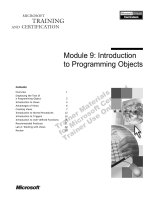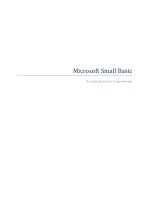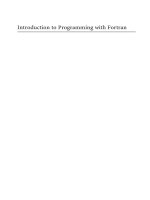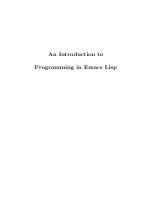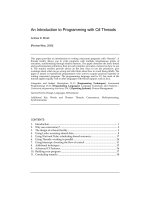Session 01 Introduction to Programming
Bạn đang xem bản rút gọn của tài liệu. Xem và tải ngay bản đầy đủ của tài liệu tại đây (372.32 KB, 27 trang )
LBC, Session 1
Introduction to Programming
FPT APTECH COMPUTER EDUCATION HANOI
Objectives
• Differentiate between Command, Program and Software
• Explain the beginning of C
• Explain when and why is C used
• Discuss the C program structure
• Discuss algorithms
• Draw flowcharts
• List the symbols used in flowcharts
LBC/Session 1
2
Software, Program and Command
Software
Program 2
Program 1
Commands
Commands
LBC/Session 1
Commands
3
The beginning of C
BPCL – Martin Richards
B – Ken Thompson
C – Dennis Ritchie
LBC/Session 1
4
Application areas of C
•
•
•
•
•
C was initially used for systems programming
A system program forms a portion of the
operating system of the computer or its support
utilities
Operating Systems, Interpreters, Editors,
Assembly programs are usually called system
programs
The UNIX operating system was developed using
C
There are C compilers available for almost all
types of PC’s
LBC/Session 1
5
Middle Level Language
High Level Language
C
Assembly Language
LBC/Session 1
6
Structured Language
• C allows compartmentalization of code and data
• It refers to the ability to section off
and hide all information and
instructions, necessary to perform a
specific task, from the rest of the
program
• Code can be compartmentalized in C by using functions
or code blocks.
LBC/Session 1
7
About C
•
•
C has 32 keywords
•
•
•
Rules to be followed for all programs written in C:
•
These keywords combined with a formal syntax form a
C programming language
All keywords are lowercased
C is case sensitive, do while is
different from DO WHILE
Keywords cannot be used as
a variable or function name
LBC/Session 1
main()
{
/* This is a sample Program*/
int i,j;
i=100;
j=200;
:
}
8
The C Program Structure-1
• C programs are divided into units called functions
• Irrespective of the number of functions in a
program, the operating system always passes
control to the main() when a C program is executed.
• The function name is always followed be
parentheses.
• The parentheses may or not contain parameters.
LBC/Session 1
9
The C Program Structure-2
• The function definition is followed by an open
curly brace ({)
• The curly brace signals the beginning of the
function
• A closing curly brace (}) after the codes, in the
function, indicate the end of the function
LBC/Session 1
10
The C Program Structure-3
• A statement in C is terminated with a semicolon
• A carriage return, whitespace, or a tab is not
understood by the C compiler
• A statement that does not end in a semicolon is
treated as an erroneous line of code in C
LBC/Session 1
11
The C Program Structure-4
• Comments are usually written to describe the task of a
particular command, function or an entire program
• The compiler ignores comments.
• There are two way to insert comments:
• Single line:
//Comments go here
• Multiline:
/*
Comments go here
and here
*/
LBC/Session 1
12
The C Library
• All C compilers come with a standard
library of functions
• A function written by a programmer can
be placed in the library and used when
required
• Some compilers allow functions to be
added in the standard library
• Some compilers require a separate library
to be created
LBC/Session 1
13
Compiling & Running A Program
LBC/Session 1
14
The Programming Approach to
Solving Problems
Algorithm is a set of steps that are performed to solve a problem. The
example below describes an algorithm:
Classroom
Leaving the
classroom
Head towards
the staircase
Go to the
basement
These are the steps followed
when a student wants to go
to the cafeteria from the
classroom
Head for the
cafeteria
Cafeteria
LBC/Session 1
15
Solving a Problem
In order to solve a problem
Understand the problem clearly
Gather the relevant information
Process the information
Arrive at the solution
LBC/Session 1
16
Pseudocode
• Is not actual code.
• Is a method of algorithm - writing which uses a
standard set of words which makes it resemble code
• Each pseudocode starts with a BEGIN
• To show some value , the word DISPLAY is used
• The pseudocode finishes with an
BEGIN
DISPLAY ‘Hello World !’
END
LBC/Session 1
17
Flowcharts
It is a graphical representation of an algorithm
START
DISPLAY ‘Hello World !’
STOP
LBC/Session 1
18
The Flowchart Symbol
LBC/Session 1
19
Flowchart to add two numbers
LBC/Session 1
20
The IF Construct
S TAR T
BEGIN
INPUT num
r = num MOD 2
IF r=0
Display “Number is even”
END IF
END
IN P U T n u m
r = n u m M OD 2
r =0
No
Yes
D IS P L AY "N u m b e r i s E ve n "
S TOP
LBC/Session 1
21
The IF-ELSE Construct
BEGIN
INPUT num
r=num MOD 2
IF r=0
DISPLAY “Even Number”
ELSE
DISPLAY “Odd Number”
END IF
END
S TA R T
IN P U T n u m
r = n um M O D 2
Yes
r = 0
D IS P L AY "N u m b e r i s E ve n "
No
D IS PL A Y " N u m b er is O d d "
S TOP
LBC/Session 1
22
Multiple criteria using AND/OR
BEGIN
INPUT yearsWithUs
INPUT bizDone
IF yearsWithUs >= 10 AND bizDone >=5000000
DISPLAY “Classified as an MVS”
ELSE
DISPLAY “A little more effort required!”
END IF
END
LBC/Session 1
23
Nested IFs-1
BEGIN
INPUT yearsWithUs
INPUT bizDone
IF yearsWithUs >= 10
IF bizDone >=5000000
DISPLAY “Classified as an MVS”
ELSE
DISPLAY “A little more effort required!”
END IF
ELSE
DISPLAY “A little more effort required!”
END IF
END
LBC/Session 1
24
Nested IFs-2
START
INPUT YearsWithUs
INPUT bizDone
YES
YearsWithUs >= 10
NO
DISPLAY “A Little more effort required”
bizDone > 5000000
NO
YES
DISPLAY “A Little more effort required”
DISPLAY “Classified as an MVS”
STOP
LBC/Session 1
25
